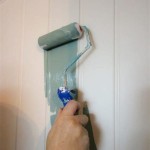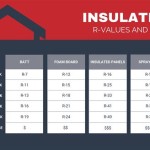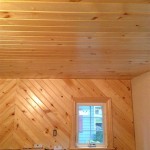What Type of Paint Is Best for Interior Walls?
Selecting the ideal paint for interior walls involves navigating a variety of options, each possessing unique characteristics and suitable for specific applications. Understanding the different types of paint, their properties, and their advantages is crucial for achieving a desired aesthetic outcome and ensuring long-term durability. The efficacy of a chosen paint depends on factors such as room usage, desired sheen, and existing wall conditions. This article provides a comprehensive overview of common interior paint types to aid the decision-making process.
The primary classifications of interior wall paint are primarily based on their binder—the component that holds the pigment together and adheres the paint to the surface. The most frequently encountered binders are latex (water-based) and alkyd (oil-based). Each binder type imparts distinct attributes to the paint, influencing its application, durability, and overall performance.
Latex-Based Paints: A Versatile and Popular Choice
Latex paints, despite their misleading name (they contain no actual latex), are water-based paints that have become the industry standard for interior walls. Their widespread adoption stems from their user-friendly nature, environmental benefits, and overall performance characteristics. Latex paints offer excellent adhesion, color retention, and ease of cleaning, making them suitable for a wide range of interior applications.
One of the key advantages of latex paint is its low volatile organic compound (VOC) content. VOCs are chemicals released into the air as the paint dries, and high levels of VOCs can contribute to indoor air pollution and pose health risks. Latex paints typically have significantly lower VOC levels compared to oil-based paints, making them a more environmentally friendly and healthier option for interior spaces. Furthermore, latex paints emit less odor during application and drying, minimizing disruption during the painting process.
Cleaning up latex paint is straightforward, requiring only soap and water. This ease of cleanup is a significant benefit, particularly for DIY projects. Latex paints also dry relatively quickly, allowing for multiple coats to be applied within a single day. This faster drying time reduces the overall duration of the painting project and minimizes inconvenience.
Latex paints exhibit good flexibility, which helps them withstand minor expansion and contraction of walls due to temperature and humidity fluctuations. This flexibility reduces the likelihood of cracking and peeling, contributing to the paint's longevity.
However, latex paints may not be the optimal choice for all situations. While they offer good adhesion, they may not adhere as well to glossy or oil-based surfaces as oil-based paints. Proper preparation, including priming, is crucial when applying latex paint over such surfaces to ensure adequate adhesion. Furthermore, latex paints may not be as durable as oil-based paints in high-traffic areas that are subject to frequent cleaning or abrasion.
Within the category of latex paints, there are several sub-types, including acrylic latex and vinyl latex. Acrylic latex paints offer superior durability, adhesion, and color retention compared to vinyl latex paints. Acrylic paints are generally recommended for areas that require greater durability, such as kitchens, bathrooms, and hallways.
Alkyd-Based Paints: Durability and a Smooth Finish
Alkyd paints, also known as oil-based paints, utilize alkyd resins as their binder. Although less prevalent than latex paints for general interior wall applications, alkyd paints retain a significant role in specific scenarios where their unique properties are advantageous. Alkyd paints are renowned for their exceptional durability, hardness, and ability to provide a smooth, enamel-like finish.
The durability of alkyd paint makes it well-suited for high-traffic areas and surfaces that are subject to frequent wear and tear. Alkyd paints resist chipping, scratching, and staining more effectively than latex paints. They are also more resistant to water damage, making them a preferred choice for areas with high humidity, such as bathrooms and kitchens.
The smooth, enamel-like finish achieved with alkyd paints is highly desirable for trim, doors, and cabinets. The paint flows and levels well, minimizing brushstrokes and creating a professional-looking result. The enhanced smoothness also makes it easier to clean and maintain alkyd-painted surfaces.
However, alkyd paints have several drawbacks that limit their widespread use. They contain high levels of VOCs, which can pose health risks and contribute to indoor air pollution. The strong odor emitted during application and drying can also be a significant inconvenience. Stringent regulations are in place to limit the VOC content of alkyd paints, leading to the development of modified alkyd formulations with lower VOC levels.
Cleaning up alkyd paint requires the use of solvents, such as mineral spirits or paint thinner. This cleanup process is more cumbersome and requires more precautions than cleaning up latex paint with soap and water. Alkyd paints also dry much slower than latex paints, requiring longer waiting times between coats.
Over time, alkyd paints can become brittle and prone to cracking and yellowing, particularly in areas exposed to sunlight. This degradation can necessitate more frequent repainting compared to latex paints.
Due to the higher VOC content and more complex cleanup process, alkyd paints are often preferred by experienced painters who understand the proper handling and application techniques. For DIY projects, latex paints are generally a more user-friendly and environmentally responsible option.
Specialty Paints: Addressing Specific Needs and Applications
Beyond the general categories of latex and alkyd paints, various specialty paints are designed to address specific needs or provide unique aesthetic effects. These specialty paints often incorporate additives or modified formulations to enhance their performance in particular situations.
Primer: While technically not a paint, primer is an essential preparatory coating applied before the topcoat. Primer serves several crucial functions, including sealing porous surfaces, improving adhesion of the topcoat, blocking stains, and providing a uniform surface for the paint to adhere to. Priming is particularly important when painting over new drywall, bare wood, or surfaces with existing stains or imperfections. Primers are available in both latex and alkyd formulations, and the choice of primer should be compatible with the type of paint being used for the topcoat.
Ceiling Paint: Ceiling paints are specifically formulated to minimize dripping and spattering during application. They typically have a flatter sheen to reduce light reflection and hide imperfections on the ceiling surface. Some ceiling paints also contain mold and mildew inhibitors to protect against moisture damage in bathrooms and kitchens.
Kitchen and Bathroom Paint: Paints designed for kitchens and bathrooms are formulated to resist moisture, mold, and mildew. They typically have a higher sheen level to facilitate cleaning and prevent the growth of microorganisms. Acrylic latex paints are often the preferred choice for these applications due to their durability and moisture resistance.
Chalkboard Paint: Chalkboard paint transforms any surface into a writable chalkboard. This type of paint is commonly used in kitchens, playrooms, and classrooms. It requires proper surface preparation and curing to ensure good adhesion and durability.
Magnetic Paint: Magnetic paint contains iron particles that allow magnets to adhere to the painted surface. It is often used in conjunction with chalkboard paint to create interactive surfaces in children's rooms or offices. Multiple coats of magnetic paint are typically required to achieve sufficient magnetic attraction.
Low-VOC and Zero-VOC Paints: As environmental awareness increases, low-VOC and zero-VOC paints have become increasingly popular. These paints are formulated to minimize the emission of VOCs, contributing to improved indoor air quality. They are available in both latex and alkyd formulations, although latex paints generally offer a wider selection of low-VOC options.
Paint with Antimicrobial Additives: In environments prioritizing hygiene, antimicrobial paints are utilized. These paints incorporate additives that inhibit the growth of bacteria, mold, and mildew on the painted surface. Common applications include healthcare facilities, food processing plants, and schools.
Epoxy Paints: Epoxy paints are typically two-part systems that offer exceptional durability, chemical resistance, and abrasion resistance. They are often used for floors, garages, and other high-wear surfaces. Epoxy paints require careful mixing and application to ensure proper curing and performance.
Choosing the appropriate type of paint for interior walls requires careful consideration of factors such as room usage, desired sheen, existing wall conditions, and environmental concerns. Latex paints offer a versatile and environmentally friendly option for most interior applications, while alkyd paints provide superior durability and a smooth finish for specific areas. Specialty paints address unique needs and provide customized solutions for various applications.

From Matte To Gloss Which Paint Finish Is Best For Your Interior Walls Asian Paints

From Matte To Gloss Which Paint Finish Is Best For Your Interior Walls Asian Paints

From Matte To Gloss Which Paint Finish Is Best For Your Interior Walls Asian Paints

From Matte To Gloss Which Paint Finish Is Best For Your Interior Walls Asian Paints

Which Type Of Wall Paint Is Best

From Matte To Gloss Which Paint Finish Is Best For Your Interior Walls Asian Paints

Five Types Of Interior Wall Paints Finishes And Their Best S My Three Sons Painting

10 Best Tips On Choosing The Right Interior Wall Paint Colours For Home

What Paint Is Best For Walls

9 Best Paints For Interior Walls The Family Handyman
Related Posts








